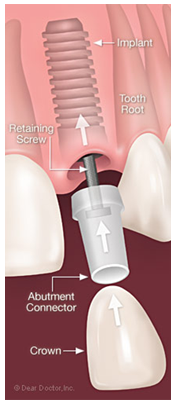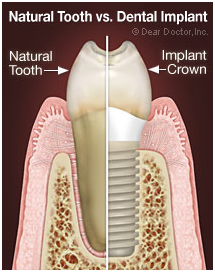DENTAL IMPLANTS

DENTAL IMPLANTS AND ROOTS
The key benefit of dental implants over other tooth replacement systems is that an implant connects directly to the jaw bone. It’s obviously not the same as the original connection, but functions just the same. When a tooth is lost, bone loss will eventually occur in that region because the root is no longer stimulating and stabilizing the bone. By using titanium--which biochemically joins to bone--to replace the root, you get a bond that more accurately replicates the one found in nature.
WHAT HAPPENS WHEN YOU LOSE A TOOTH?
you don’t need to replace it, since no one can see that it’s missing and you have plenty of other teeth. However, there is more bone loss going on under the surface once a tooth is lost. Surrounding each tooth is an alveolar bone that supports the tooth and when the tooth is lost, that bone basically melts away. This is why people who have lost most of their teeth and are not wearing dentures appear to have a caved-in appearance to their mouths.
Besides causing damage to the immediate area, tooth loss affects remaining teeth as well. Teeth create a structure for the face and their loss can shift the surrounding teeth, creating esthetic issues and bite problems. A lost tooth can also affect facial structures such as the jaw, muscles, jaw joints, and even the skin. If several teeth are lost, it’s not uncommon to suffer from social consequences and poor nutrition.
REBUILDING BONE
When the supporting alveolar bone melts away, it’s gone for good, but through grafting, a skilled dental professional can recreate bone to fuse with and support an implant. This is wonderful news, but it is still best to have a dental implant as soon as possible after the tooth is lost for the most predictable esthetic outcome.

DENTAL IMPLANTS VS. FIXED DENTAL BRIDGES
What Are Dental Implants?
Dental implants are actually a series of procedures used to recreate a missing tooth. The key part of a dental implant is the initial titanium implant which sits in the original tooth’s bone pocket, or alveolus. The titanium works well with the bone and actually forms a bond with it over time, much like the original bond between the tooth and the jaw bone. This is essential as it prevents bone loss that would normally occur with any other type of tooth replacement. Dental implants are capped with a crown, which replicates the enamel or visible portion of a tooth, and in many cases the replacement tooth will work just as well, if not better, than the original tooth.
What Is a Fixed Dental Bridge?
A fixed dental bridge is a non-removable prosthesis attached to remaining natural teeth The false tooth or teeth literally bridge the gap between natural teeth. For a long time, fixed bridges were the best alternative for people who had lost teeth, as they were quite successful and esthetically pleasing. Unfortunately, bridges can also present some problems because the natural teeth that lie on either side of the bridge are filed to accept the appliance. This step in the bridge-making procedure may make these teeth prone to bacterial plaque accumulations, decay, periodontal disease, and the possible need for future root canals.
Cost Breakdown: Implant vs. Bridge
At first glance, it appears that a bridge is the more economical route, with total fees for a typical implant starting at the top end of the cost for a fixed bridge and ending a couple thousand dollars higher. But when comparing cost versus value, the dental implant is more cost-effective and the better treatment option – if the patient is a candidate for implants


